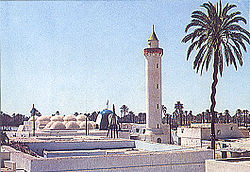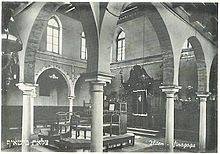Zliten
Zliten
زليتن | |
|---|---|
Town | |
 | |
|
UTC+2 (EET) | |
| • Summer (DST) | UTCLibya |
| License Plate Code | 36 |
| Website | zliten |
Zliten (
Geography
The name Zliten is given to both the city and the whole area. As a city, Zliten is situated 160 km (99 mi) east of the capital,
Climate
| Climate data for Zliten | |||||||||||||
|---|---|---|---|---|---|---|---|---|---|---|---|---|---|
| Month | Jan | Feb | Mar | Apr | May | Jun | Jul | Aug | Sep | Oct | Nov | Dec | Year |
| Mean daily maximum °C (°F) | 17.6 (63.7) |
19.7 (67.5) |
22.1 (71.8) |
25.4 (77.7) |
27.3 (81.1) |
31.5 (88.7) |
33.0 (91.4) |
33.6 (92.5) |
30.6 (87.1) |
29.3 (84.7) |
24.1 (75.4) |
19.7 (67.5) |
26.2 (79.1) |
| Mean daily minimum °C (°F) | 7.6 (45.7) |
8.8 (47.8) |
10.4 (50.7) |
13.6 (56.5) |
16.0 (60.8) |
19.5 (67.1) |
21.3 (70.3) |
22.3 (72.1) |
19.6 (67.3) |
18.1 (64.6) |
13.8 (56.8) |
9.8 (49.6) |
15.1 (59.1) |
| Average precipitation mm (inches) | 50 (2.0) |
27 (1.1) |
17 (0.7) |
8 (0.3) |
4 (0.2) |
1 (0.0) |
0 (0) |
0 (0) |
9 (0.4) |
34 (1.3) |
31 (1.2) |
52 (2.0) |
233 (9.2) |
| Source: Climate-data.org | |||||||||||||
Name
The name is derived from the name of the Isliten tribe, an old branch of the Nafzawa Berbers. Members of this tribe used to live in Libya and Tunisia, but are also known to have lived as far west as Morocco. They are mentioned by Leo Africanus in the 16th century as living in western Libya.[1]
Education
Zliten is home to one of Libya's most renowned
Economy
Zliten has several modern
History and culture

There are many ancient
On Friday, 24 August 2012 the shrine of Sidi Abdul-Salam Al-Asmar Al-Fituri suffered extensive damage at the hands of violent
Recent work on the region (dating between 2003 and 2017) using Google Earth imagery has identified 278 certain or potential archaeological sites within Zliten. The majority of these sites were determined as structures or enclosures, and their purpose, for most, interpreted as related to agricultural activities which the primary land use today. These 278 sites recorded in the EAMENA(Endangered Archaeology in the Middle East and North Africa) database of the Zliten area. In this database, 170 sites were marked as in good condition, 50 in fair condition, 24 sites in poor condition, 15 in very bad and 16 recorded as completely destroyed, (with 3 in unknown conditions). Although this work was undertaken as recently as 2017, the developments in Libya, the political and economic situation affect both the management and very survival of Libya's ancient sites. Archaeological sites, as in Iraq, Syria and Afghanistan do not comply to militant revolutionaries' aims, they are thus expendable and can/or in some cases 'must' be destroyed (https://www.nature.com/news/cultural-heritage-save-libyan-archaeology-1.16781). The EAMENA aim to track these sites and their condition while the (Society of Libyan Studies) publish reports aiming to promote Libyan archaeology, history and environment.
Rubb
Zliten has a proliferation of
Zliten during the Libyan Civil War (2011)
During the
On 5 August, the Libyan government claimed that NATO airstrikes killed 85 people, including 33 children, 32 women and 20 men, attacking a children's hospital near Zliten.[18] Reporters were shown 30 bodies in a local morgue, including two children. Officials claimed that the rest of the bodies were taken to other hospitals, but this could not be independently confirmed.[19]
On 19 August 2011, the rebels made a major push and drove loyalist forces out of the city.[20]
Zliten during the Second Libyan Civil War
On January 7, 2016, during the
See also
References
- ^ Description of Africa
- ^ P. Mobbs 2001 p. 19.1
- ^ P. Mobbs 2005 p.25.1
- ^ Tripoli focuses on lack of cement supply: (2005) Middle East Economic Digest, v. 49, no. 26, p. 25
- ^ M. Ashour (2004) p.216
- ^ A. Ham p.148
- ISBN 9781134126538
- ^ Enas Saddoh, Extremists demolish Libya’s shrines using bulldozers, explosives. France 24, 29/08/2012.
- ^ Mohamed, Essam (27 August 2012) Libyan salafists destroy Sufi shrines magharebia.com
- ^ Fornaji, Hadi (28 August 2012) Widespread condemnation of mosque attacks and demands for government action libyaherald.com
- ^ "UNESCO Director-General calls for an immediate halt to destruction of Sufi sites in Libya". Media Services (Press release). UNESCO. 28 August 2012. Archived from the original on 17 October 2012.
- ISBN 978-0-19-512558-0.
- ^ A. Ham p.147
- ISSN 0362-4331. Retrieved 13 July 2014.
- ^ "Libya rebels inch closer to Tripoli". Oman Tribune. Retrieved 13 July 2014.
- ^ "Nations Formally Support Libyan Opposition". SkyNews. 15 July 2011. Retrieved 17 July 2011.
- ^ "U.S. recognizes Libyan rebels' authority". CNN. 15 July 2011. Retrieved 17 July 2011.
- ^ "Video : Libya government: NATO air missiles targeted children's Hospital in Zlitan". uruknet.info. 5 August 2011. Retrieved 13 July 2014.
- ^ "WRAPUP 1-Tripoli says NATO strike kills dozens of civilians". Reuters. 9 August 2011. Archived from the original on 26 September 2012.
- ^ "Libyan rebels capture city near Tripoli". Al Jazeera English. 19 August 2011. Retrieved 19 August 2011.
- ^ "An Islamic State affiliate claims credit for Libya attack". Business Insider, Associated Press. 8 January 2016. Retrieved 8 January 2016.
Bibliography
- Mukhtar M. Ashour (2004), Economics of seawater desalination in Libya Tajora Research Center
- J.M. Cowan (1994), The Hans Wehr Dictionary of Modern Written Arabic
- Anthony Ham (2002), Lonely Planet: Libya. Lonely Planet Publications
- Philip M. Mobbs (2001), The Mineral Industry of Libya
- Philip M. Mobbs (2005), Minerals Yearbook: Libya, USGS
- Alison Pargeter (2006) Libyan Fighters Join the Iraqi Jihad, Terrorism Monitor V. 4, Issue 23
External links
- Zliten “Cities of the Saints”
- Zliten Hotel
- D. Mattingly; R. Talbert; T. Elliott; S. Gillies. "Places: 344573 (Zliten)". Pleiades. Retrieved 8 March 2012.
